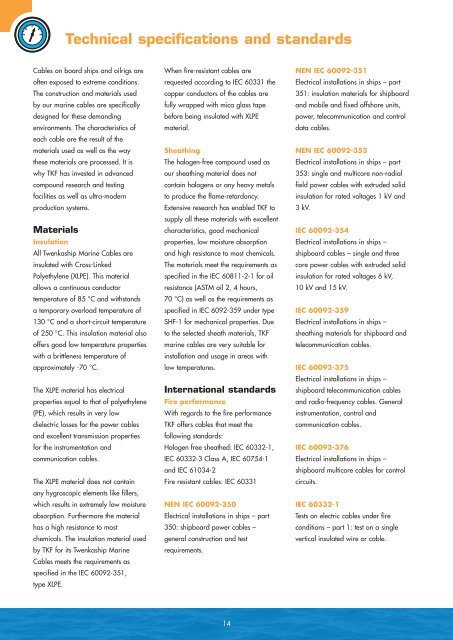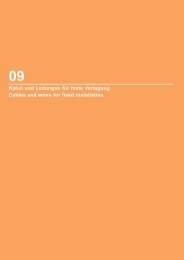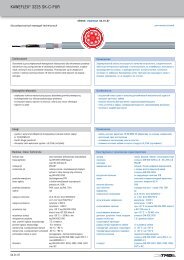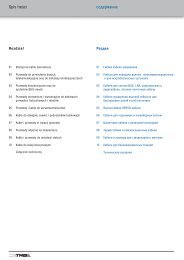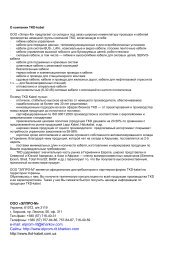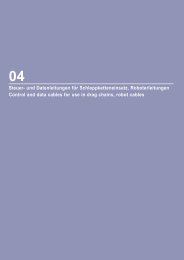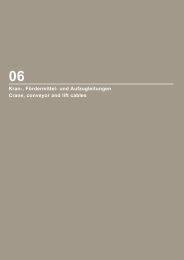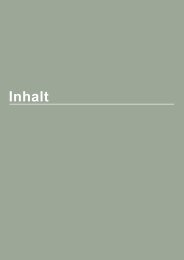Twenkaship Marine Cables - TKD-KABEL | Продукция
Twenkaship Marine Cables - TKD-KABEL | Продукция
Twenkaship Marine Cables - TKD-KABEL | Продукция
You also want an ePaper? Increase the reach of your titles
YUMPU automatically turns print PDFs into web optimized ePapers that Google loves.
Technical specifications and standards<strong>Cables</strong> on board ships and oilrigs areoften exposed to extreme conditions.The construction and materials usedby our marine cables are specificallydesigned for these demandingenvironments. The characteristics ofeach cable are the result of thematerials used as well as the waythese materials are processed. It iswhy TKF has invested in advancedcompound research and testingfacilities as well as ultra-modernproduction systems.MaterialsInsulationAll <strong>Twenkaship</strong> <strong>Marine</strong> <strong>Cables</strong> areinsulated with Cross-LinkedPolyethylene (XLPE). This materialallows a continuous conductortemperature of 85 °C and withstandsa temporary overload temperature of130 °C and a short-circuit temperatureof 250 °C. This insulation material alsooffers good low temperature propertieswith a brittleness temperature ofapproximately -70 °C.The XLPE material has electricalproperties equal to that of polyethylene(PE), which results in very lowdielectric losses for the power cablesand excellent transmission propertiesfor the instrumentation andcommunication cables.The XLPE material does not containany hygroscopic elements like fillers,which results in extremely low moistureabsorption. Furthermore the materialhas a high resistance to mostchemicals. The insulation material usedby TKF for its <strong>Twenkaship</strong> <strong>Marine</strong><strong>Cables</strong> meets the requirements asspecified in the IEC 60092-351,type XLPE.When fire-resistant cables arerequested according to IEC 60331 thecopper conductors of the cables arefully wrapped with mica glass tapebefore being insulated with XLPEmaterial.SheathingThe halogen-free compound used asour sheathing material does notcontain halogens or any heavy metalsto produce the flame-retardancy.Extensive research has enabled TKF tosupply all these materials with excellentcharacteristics, good mechanicalproperties, low moisture absorptionand high resistance to most chemicals.The materials meet the requirements asspecified in the IEC 60811-2-1 for oilresistance (ASTM oil 2, 4 hours,70 °C) as well as the requirements asspecified in IEC 6092-359 under typeSHF-1 for mechanical properties. Dueto the selected sheath materials, TKFmarine cables are very suitable forinstallation and usage in areas withlow temperatures.International standardsFire performanceWith regards to the fire performanceTKF offers cables that meet thefollowing standards:Halogen free sheathed: IEC 60332-1,IEC 60332-3 Class A, IEC 60754-1and IEC 61034-2Fire resistant cables: IEC 60331NEN IEC 60092-350Electrical installations in ships – part350: shipboard power cables –general construction and testrequirements.NEN IEC 60092-351Electrical installations in ships – part351: insulation materials for shipboardand mobile and fixed offshore units,power, telecommunication and controldata cables.NEN IEC 60092-353Electrical installations in ships – part353: single and multicore non-radialfield power cables with extruded solidinsulation for rated voltages 1 kV and3 kV.IEC 60092-354Electrical installations in ships –shipboard cables – single and threecore power cables with extruded solidinsulation for rated voltages 6 kV,10 kV and 15 kV.IEC 60092-359Electrical installations in ships –sheathing materials for shipboard andtelecommunication cables.IEC 60092-375Electrical installations in ships –shipboard telecommunication cablesand radio-frequency cables. Generalinstrumentation, control andcommunication cables.IEC 60092-376Electrical installations in ships –shipboard multicore cables for controlcircuits.IEC 60332-1Tests on electric cables under fireconditions – part 1: test on a singlevertical insulated wire or cable.14


